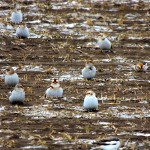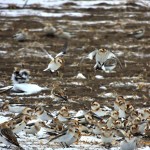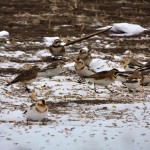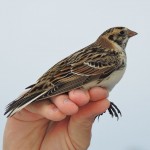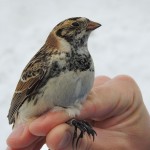31 January 2014. Haldimand ON. Thank goodness, a thaw. With temperatures just a shade above freezing for a change, I saw several noteworthy species today: Three Wild Turkeys picking through snow-encrusted corn stubble; a lone male Northern Harrier quartering wind-blown farm fields; a Rough-legged Hawk keeping watch atop a large oak; Tumbling squalls of Snow Buntings; A scattering of Horned Larks and, Bird of the Day, two or three Lapland Longspurs.
Let me put it all into context. I returned to that same quiet, windswept, country road to continue our work banding Snow Buntings. A couple of days of fierce winds had exposed wide expanses of farmland stripping the soil and blowing it onto roadside snow-drifts, turning them coffee coloured.
Without a covering of snow, birds find it easier to forage for more traditional sources of food so our baited ground traps were far less effective. Still, we banded twenty-two Snow Buntings and one Lapland Longspur.
Snow Buntings, they are so aptly named, move in very large rolling flocks that barrel across the landscape like a loose-leafed snow squall. Horned Larks and Lapland Longspurs seem to get caught up in the excitement of the buntings’ wanderings and we’ll usually see a few of them, and maybe band a handful. (Click on any photo below to really appreciate their cuteness.)
Horned Larks are probably one of our most under-noticed birds, they prefer open farm fields, the rougher, bleaker and more disturbed the better and while winter is still tossing around late snow and ice, Horned Larks start nesting, often tucking a nest in a crevice between clumps of old grasses and weeds. We saw a score of Horned Larks today but none that wanted to settle for us to enjoy them for long.
Lapland Longspurs are smaller and have a diminutive charm of their own. Like the buntings, they nest in tundra far above the tree line but spend the winter foraging over open fields in southern Canada and much of the U.S. It’s a privilege to see them after they’ve gone to all that effort to visit us. Few birders notice them because they can be so hard to find in those large flocks of Snow Buntings. The one that surrendered itself for banding was much admired, enough to be Bird of the Day.
This post contains photos in galleries visible only on the website, not if you’re reading this as an email.
